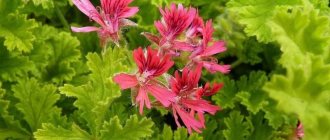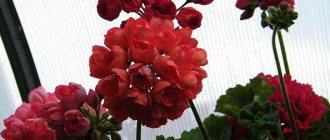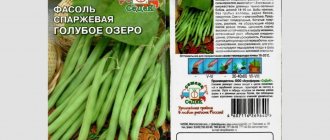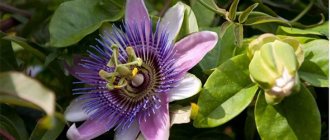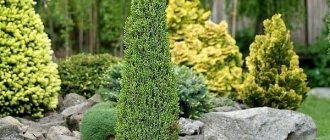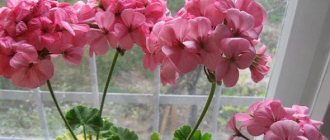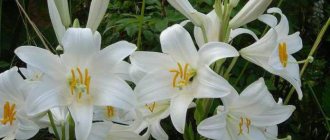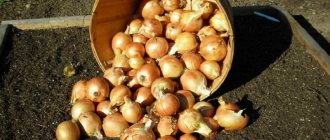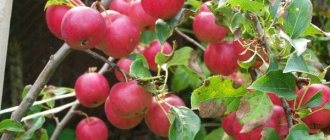The ancestral homeland of royal pelargonium is the Cape Lowlands of South Africa. From here, first to England, and then throughout the world, many indoor species were brought, including pelargonium. By crossing several varieties, breeders obtained royal pelargonium.
The most beautiful representative of pelargoniums is the royal geranium. This beautiful indoor flower differs from related varieties in its lush flowering. Bright and delicate inflorescences do not rise above the bush on a peduncle, as in other representatives of the genus, but are level with the green mass of the flower. The bush itself is more lush. The short stem is densely covered with green leaves. The inflorescence is larger than most species and reaches up to 15 centimeters in diameter. In some varieties, the flower alone reaches 7 centimeters in diameter. An example of such a variety is White Glory pelargonium. Thanks to the lush and friendly flowering, forming a continuous cap over the bush, the plant received the name royal (royal, large-flowered) geranium. In some representatives of the species, the flower has two upper and three lower clearly defined petals. The upper petals are always more brightly colored and resemble pansies in appearance.
Pelargonium White Glory
Royal pelargonium, like all geraniums, has extremely beneficial properties. People suffering from allergies and asthma should treat it with caution, but for others it can become a source of energy. Essential oils and phytoncides secreted by the flower relieve stress, relieve irritability and tension. Red varieties of pelargonium can help in relationships. Phytoncides and essential oils secreted by the plant relieve insomnia. Used in cosmetology as a component of massage oils: for varicose veins, hair and skin care. This flower is also endowed with the ability to harmonize relationships, attract happiness, love and understanding into the home. It is believed that the plant promotes financial well-being, relieves and protects the house from the evil eye and damage. To do this, it is recommended to get him an azalea as a mate.
The bright decorative appearance of the bush and lush flowering with proper care will last from March to October. To do this, the flower must be trimmed, fed and maintained in a timely manner.
Description
Royal pelargonium, with the exception of a few varieties, differs from other geraniums in its weakly expressed aroma. The height of the plant does not exceed 50 centimeters. Large inflorescences are distinguished by a wide variety of colors. There are white, pink, burgundy, purple and almost black varieties. Some petals have a pattern in the form of spots, dashes and veins. The petals can be double with a wavy edge or even, opening flat. Royal geranium flowers are collected in an umbrella inflorescence, reaching 15 centimeters in diameter and covering the entire plant. Flowers on royal pelargonium appear in March-April, flowering ends in September.
The leaves are entire, lobed, with a wavy edge, sometimes finely serrated. Green color. The leaves are fleshy and covered with villi, although some representatives do not have them. The leaves are attached to the stem by cuttings, the leaf arrangement is alternate. The stem is erect, dense, almost completely hidden by foliage. The root system is fibrous.
In autumn, the plant does not lose its decorative effect; later it retains dense green foliage throughout the winter. After purchasing a flower, do not rush to replant it. Place the pelargonium on the windowsill where it will grow, let it acclimate for two weeks or wait until it finishes blooming. Only after this the flower can be transplanted.
How to root?
If propagation was carried out by cuttings, then the young pelargonium should be transplanted into a separate flower pot using the transfer method, that is, together with a lump of earth, without shaking off the soil from the roots.
Pelargonium shoots grown from seeds are planted in separate pots after the formation of their root system.
The container is first filled with drainage, and then with a loose and light substrate (a mixture of peat and sand or peat and vermiculite in a 1:1 ratio), which is well moistened before planting the shoot. We should not forget that a prerequisite for dishes is the presence of drainage holes at the bottom, necessary for draining excess liquid.
Royal pelargonium requires a slightly cramped pot for lush and abundant flowering. If a flower is planted in a spacious pot, the plant will direct all its efforts to filling the entire volume with roots, and in this case you should forget about flowering (read about why royal pelargonium does not bloom and how to correct the situation here).
Varieties and types
Currently, more than 1000 varieties of royal geranium have been bred. Selection mainly continues to be carried out in Germany. Royal pelargonium varieties are divided into several groups.
The Candy Flowers group includes resistant varieties with lush flowering. These flowers feel great in open ground. These include, for example, the Cambi variety with beautiful delicate flowers, spots on the petals and light pink veins.
Cambi
There are pelargoniums with large inflorescences of dark cherry color and dark spots on the petals, as, for example, in the Camred and Candy Flowers Bright Red varieties.
In the Camdared variety, the outer and inner sides of the petals are painted in different shades. The bright red inner and pale outer sides of the petal add additional volume to the inflorescence.
Candy Flowers Pink with Eye - a variety with dark spots on pink leaves.
The Angels pelargonium group includes miniature varieties with a short flowering period. They feel great at home in winter. The structure of the stem allows them to be grown as hanging varieties. They do not need wintering with lower temperatures to form buds. Unlike most varieties of royal pelargonium, representatives of this variety have foliage with a pronounced aroma. Among the most common varieties, Spanish Angel is the most popular. The flower does not exceed 35 centimeters in height. The flowers are painted in two tones: the upper ones are darker, and the lower ones are light purple. The diameter of each flower does not exceed 3.5 centimeters.
The Imperial Butterfiy variety also belongs to miniature varieties, not exceeding 30 centimeters in height. Cute white flowers with purple dashes have a pleasant lemon aroma.
Two-color varieties include Darmsden. The plant is not large and will fit compactly on the windowsill. The upper petals are dark cherry color. The lower ones are white, there may be dashes.
PAC Angeleyes Viola is a variety with a pleasant citrus aroma and a beautiful lush inflorescence of delicate almost white flowers with a pink spot on each petal.
Some varieties of pelargonium are capable of blooming several times per season. For example, the Sally Munro variety. It pleases the eye with two-color flowers with dark cherry upper petals and pale pink lower petals.
The white varieties beloved by many, among which the Mona Lisa variety boasts the most lush flowering, will decorate any window.
Varieties with a wavy flower edge are popular. A representative can be considered Georgina Blythe - with red-orange flowers, a white neck and a white edging on the petals. The variety is so small that it rarely exceeds 35 centimeters in height. The Morwenna variety also has a beautiful edge. The plant is so dark in color that it is often confused with black. However, it can be described as a dark burgundy velvet color.
Features of summer care at home
Pelargonium blooms in summer. The flower only needs watering and feeding. If he is in the fresh air, then carefully monitor the temperature. At values below +22...+24 °C, watering is reduced, below +10 °C, and the uniformity of drying of the earthen clod is regularly checked. Excessive moisture can cause root rot and mold growth. It is recommended to water in the early morning before the heat sets in or in the evening, when the sun no longer shines and goes into sunset.
For feeding, fertilizers with minimal or no nitrogen content are used.
On the street, pelargonium is constantly checked for pests. When they are detected, they are immediately treated with an insecticide so that the plant does not get sick or die. When choosing a location, avoid direct light.
The sun's rays may leave burn marks on the foliage or it will change color to scarlet. Royal geranium does not tolerate changing places well, so it is advised not to plant it in open ground or to do it together with a pot to preserve the rhizome from insect attacks.
Plant care
Caring for royal geraniums is not much different from caring for other members of the pelargonium family. The plant is native to South Africa. The flower was obtained by crossing several varieties specifically for home cultivation. The flower turned out to be warm and light-loving. Royal pelargonium is fastidious in care, but for its lush flowering it is very fond of gardeners. To obtain long-lasting flowering, you must follow some rules.
Features of summer care at home
Caring for royal geraniums at home is easy. In summer, the flower is in a blooming state, so all pruning procedures are stopped before the flower buds begin to form. All that remains is to water and feed with fertilizer. The fertilizer should not contain nitrogen, a small amount is acceptable. Faded flowers should be removed in a timely manner, this will prolong flowering and preserve decorative properties.
Average temperatures outside are comfortable for pelargonium; it can be exposed to fresh air. If temperatures drop below 22 degrees in early spring or autumn, the flower may be susceptible to various bacterial and fungal diseases, especially if this is associated with excessive watering. Also, low outdoor temperatures can cause leaves to turn red.
If a flower pot is placed outside, be careful about watering it. Temperature changes can lead to uneven drying of the earth ball. The best time to water is before 10 am or after 6 pm if you are sure that the night will be warm. Despite the fact that the plant is from a very hot climate zone, direct sunlight can damage the delicate petals of the flower.
Pelargonium outdoors in summer requires special attention and regular inspection for the presence of insect pests. When the first signs of pests appear, the plant must be isolated and treated with an insecticide. It is not recommended to plant a flower in a flowerbed without a flower pot. The roots of the plant can be damaged by insects; besides, royal pelargonium, unlike zonal pelargonium, does not like frequent replanting.
Features of winter care at home
At home, caring for royal geraniums comes down to ensuring a period of rest with a decrease in temperature to 10-15 degrees. Only varieties from the Angels group do not need wintering; they can continue to be kept at normal room temperature. Overwintering pots should stand for at least two months. At this time, reduce watering and pinch the bush. Before wintering, the plant is prepared, the flower is trimmed by 1/3 and feeding is stopped. This will allow you to get more luxuriant flowering next year and extend it to 9 months.
Location and lighting
Pelargonium is a very light-loving plant, but direct sunlight can harm it. Keeping them in a room that is too dark will cause the stems to stretch out too much and they will become thin and pale green in color. Lack of light in winter will negatively affect flowering. The optimal location of pelargonium is on an east or west window. On the windowsill of a south window, it is better to shade the plant from direct sunlight.
Temperature
Pelargonium is a heat-loving plant. For summer maintenance, the street conditions of the middle zone are suitable for her. Temperature +22…+27° is most optimal. If the temperature rises, the plant needs to be watered more often: twice a day before 10 and after 18 hours.
In winter, the temperature must be reduced to -10...-15°. You can keep the plant on a heated loggia or in a greenhouse. It is necessary to take into account that the amount of light should not decrease significantly. On cold window sills, usually with wooden frames, the flower will also be comfortable. The above temperature allows the plant to lay flower buds, gives the opportunity to rest and ensures early, lush flowering.
Watering
Due to the fact that the flower needs a change in temperature, watering also needs to be adjusted. On hot summer days, watering should be increased to twice a day. Indoors in the summer, one to two waterings per week are sufficient. When kept cold, watering is reduced to once a week. Before each watering, you need to make sure that the earthen ball is dry. Overwatering in cold weather leads to damage to the plant by root rot and powdery mildew.
Feeding and fertilizers
Pelargonium grandiflora prefers cramped pots and can grow in the same pot for several years. The soil is depleted, and there is a need for fertilizing. In early spring, emerging from the dormant period, nitrogen-containing fertilizers will be useful for the flower. They will help the plant “wake up” and begin to grow actively, forming thick green foliage. During the flowering period, phosphorus should predominate in the fertilizer - an element that promotes lush flowering. They begin to feed the plant with fertilizers for flowering in March, and finish feeding in September. Overuse of fertilizers in winter can harm the formation of flowers. If the pot is located outside and needs frequent watering, then the plant will have to be fertilized more often, since trace elements are washed out along with the water.
Trimming
Every year after flowering, before the geranium retires, the plant is cut back by 1/3 or 2/3. This procedure is carried out to obtain more luxuriant flowering in the future and preserve the decorative appearance of the flower. Timely pruning will allow air to circulate freely inside the bush and protect it from rot and insects. Autumn pruning is necessary for almost all varieties of pelargonium, but in spring it is not necessary.
Before the flower begins active growth in the spring, it is inspected, very thin and long shoots are cut off. In spring, pruning begins in February, no later than March. This is done with caution so that at least 3-4 internodes remain on the shoot. By pruning you can form a standard plant. To do this, remove the lower branches and leaves, leaving one large trunk. The stem of pelargonium is very fragile and, when formed in this way, needs support.
Step-by-step instructions for pruning pelargonium:
- A sharp knife or blade is suitable for pruning. The instrument must be disinfected with alcohol or boiling water.
- Shoots for pruning are selected that are weakened, very elongated and create excessive density in the center of the bush.
- The cut is made at an angle, in the direction from the center to the periphery of the bush, above the leaf node. If the leaves are not needed in this place, the cut is made under the leaf node.
- The cut areas are treated with charcoal or cinnamon powder.
- If the shoots are young and thin, you can pinch them with dry, clean fingers.
- After the procedure, the plant is fed with nitrogen-containing fertilizer. This will allow the plant to withstand stress more easily.
- Royal pelargonium is very sensitive to pruning. To cause less damage to the plant, it is recommended to divide the pruning procedure into two stages, carried out within 1-2 months.
Royal pelargonium is very sensitive to pruning. To cause less damage to the plant, pruning procedures are recommended to be divided into two stages and carried out over 1-2 months.
After pruning, cuttings remain that can be used to grow new plants, as well as grafting to obtain an interesting and more durable flower. Using grafting, stamp species are obtained. In this way you can get a tree with different flowers on one bush. For royal pelargonium, it is better to choose fragrant pelargonium as a support. The basis should be a healthy plant at least one year old. It is better to plant miniature varieties in early spring during the period of active growth.
Possible problems in growing
Even the most experienced gardeners are not one hundred percent protected from the problems that arise when growing royal geraniums. It's even more difficult for beginners.
Drops buds and leaves
If the leaves and buds of the royal geranium begin to fall off, then with a high probability we can say that the room is too hot and the air is very dry. Also, these symptoms sometimes indicate insufficient lighting. You will need to turn on the phytolamp, install a humidifier and take measures to reduce the temperature in the room. If the house is cool, then it is enough to limit yourself to additional lighting and monitor the humidity.
Due to the heat, the royal geranium sheds its leaves and buds
The leaves are turning pale
A change in the color of the leaf blade is provoked not only by a deficiency of microelements (in particular nitrogen), but also by a lack of light, as well as excess moisture. It is urgent to analyze these factors and eliminate the cause.
The tips of the leaves are drying out
This problem in royal geranium most often occurs due to moisture deficiency. You should increase the number of waterings and resort to air humidification, but you should not be too zealous.
The lower leaves fall off
The fact that the lower leaves begin to turn yellow and fall off is caused by both a lack of moisture or nutrients in the soil, as well as a lack of light and poor ventilation of the bush. This symptom also signals rotting of the root system, which can lead to the death of the flower.
Pests
The most dangerous pests for royal geraniums are:
- mite;
- weevils;
- whitefly;
- aphid.
Royal geranium is susceptible to pests
To get rid of parasites, you should wipe the inside of the leaf blade with chamomile infusion and leave the plant for a couple of hours, then rinse everything off. If such actions do not bring a positive result, use an insecticide. Step-by-step instructions for its use are contained in the attached documentation.
Other problems
Sometimes the trunk of the royal geranium begins to rot. This indicates that the plant is affected by blackleg. The development of this disease is caused by excessive watering or low temperatures. Sick plants need to be disposed of and the pot disinfected.
Sometimes gardeners wonder why geraniums are green but lethargic? First of all, you should immediately reduce watering. Otherwise, the flower will bleat with gray rot. The scarlet tint of the leaves indicates low temperatures or the presence of drafts.
Diseases and pests
Royal pelargonium is a strong, healthy species that is susceptible to disease and attack by insect pests only if it is not properly cared for.
The appearance of brown spots on the leaves indicates infection of the plant with gray rot. The cause of the disease is excessive moisture and high nitrogen content in the soil. You can fight the disease by treating the plant with Fundazol or Vitaros. The flower will have to be replanted.
A black stem at the base indicates damage to root and stem rot. With this disease, the flower becomes sluggish, the leaves turn yellow and fall off. The reason is the increased acidity of the soil, its severe waterlogging. It is necessary to treat the plant with Bioporam or Fitolavin.
Flowers that are planted in a flower bed in the summer are more likely than others to suffer from late blight. The disease manifests itself in general lethargy of the plant, slower growth, and the appearance of spots with white fluff. The geranium must be replanted, the damaged area must be cut with a sterile knife to a healthy area, then treated with charcoal. During replanting, completely replace the soil and disinfect the pot. The transplanted plant is spilled with Bordeaux mixture.
Sometimes tubercles and growths form on the plant. This disease is called Eden. The reason for the appearance is waterlogging of the soil. If signs of infection are detected, the affected leaves are cut off and watering is reduced.
Among the insect pests that pose a danger to royal pelargonium are: aphids, mites, whiteflies and caterpillars. Many insects are visible to the naked eye: traces of their vital activity are visible on the flower, cobwebs appear, leaves wither and turn yellow. Caterpillars prefer the tender buds of pelargonium. To combat them, insecticides such as “Marathon”, “Fitove” are suitable. “Aktara” is also suitable for juice-sucking insects; for some time it will become poisonous to them.
All plant treatments must be carried out outdoors in calm weather, avoiding direct sunlight. Aspirin or soap solution can be used indoors for pest control. To do this, dissolve one aspirin tablet in 8 liters of water and spray the plant once every 3 weeks. Wipe the leaves with a cotton pad soaked in a soapy solution or spray the entire plant with a spray bottle. It is better to test on one sheet of paper first to see the reaction.
If the royal geranium does not bloom, it is worth taking a closer look to see if there are any insects or fungal infections on it. The affected plant is not able to bloom, since a lot of energy is spent on resisting the disease.
Description and photo
The homeland of this flower is South America, which is why it loves hot climates with high air humidity. Royal pelargonium is a bushy plant from 30 to 60 centimeters. Its distinctive feature from other species is its large inflorescences and unusual folded leaves. The flowers are large in the form of umbrellas, which are collected in spheres.
Flower sizes can reach 7 cm . Flowers can be either simple or double, from white to dark purple. It depends on the plant variety. Also, the color of the petals can be multi-colored. The foliage of this pelargonium is also different from other species. It is quite large, rough to the touch and has curly jagged edges.
Next you can see a photo of royal pelargonium:
Necessary growing conditions
- Air . From March to August, the plant needs an air temperature of +25 degrees. This temperature is needed for the best development of the flower. In autumn and winter, the temperature should not be allowed to rise above +20 degrees. The optimal temperature for a flower is +17…+19 degrees.
- Light . This variety loves light very much. Therefore, it is worth growing it in a well-lit place. However, on hot summer days it should be shaded, as direct sunlight can leave burns on the plant.
- Humidity . High humidity is required for good flower growth and development. Royal pelargonium needs frequent, regular and moderate watering. It is necessary to water in the morning and evening in a dosage of 50 ml per adult plant.
- Drafts . Do not place a flower pot in a room where there are drafts. Pelargonium can die from them, since sharp air currents harm it.
Planting and propagation
Royal geranium is easily propagated by cuttings, dividing the bush and seeds. The most popular method of propagation is by cuttings; sufficient quantities of them are formed after the formation of the bush.
Propagation by seeds is a more complex and lengthy process. It will not be possible to obtain seeds on your own, since all representatives of pelargonium are hybrid forms, their seeds do not retain all the characteristics of the mother plant. It is safer to buy seeds in a store. Plants obtained this way will be stronger and healthier, with a longer flowering period.
The seeds are evenly distributed over loose soil, which must necessarily include sand or perlite (at least half of the total mass of the soil). The soil must be calcined or shed with a solution of potassium permanganate. The seeds are sprinkled with damp sand and slightly buried. The entire container is covered with glass or film, placed in a well-lit place, without direct sunlight, maintaining a temperature of +21...+25°.
When real leaves appear, the seedlings are distributed into individual pots no larger than 10 centimeters in diameter and 14 centimeters in depth, with drainage holes and a layer of expanded clay. After the appearance of the fifth true leaf, the seedlings are pinched. This stimulates branching and allows you to get a more lush bush.
When and how to replant a plant?
Pelargonium can grow in one pot for a long time. Unlike its relatives, zonal geraniums, royal geraniums do not tolerate transplanting into the garden in the summer. The plant may die from frequent changes of location and replanting.
Replanting the plant is required when the pot is completely filled with roots. The new pot should be 1.5 - 2 centimeters larger than the previous one. A very large pot will slow down the growth of the plant and may cause a lack of flowering and even death of the flower. The plant will not form flower stalks until the root system completely fills the entire pot. The best for pelargonium is a shallow and not very wide pot made of unglazed ceramics. You can plant it in a plastic pot, but you will have to be careful about watering.
At the bottom of the pot there must be a good layer of drainage, for which you can use expanded clay or fragments of ceramics. It is recommended to cut and place a circle of cotton fabric on top of the drainage. It will retain small soil particles and prevent them from being quickly washed out. The soil can be purchased at the store: any neutral soil that does not contain moisture-retaining components, such as sphagnum, will do. Dense, heavy soil must be additionally enriched with perlite. The substrate for planting should be loose and moderately nutritious. You can make the soil yourself. To do this you will need peat, sand and leaf humus. Royal pelargonium prefers neutral or slightly alkaline soil; you can add a little ash to the mixture.
The survival rate of the plant depends on the time of year. The optimal time for transplantation is February, March and April. The awakened bush, entering the phase of active growth, easily tolerates transplantation. It will be more difficult for a flower transplanted in the fall to adapt. Unless absolutely necessary, it is better to avoid replanting the plant in summer or winter. During flowering, the resulting stress can lead to the death of the buds and the death of the entire flower.
A plant purchased in a store must be left for two weeks to adapt and undergo quarantine. During this time, the pelargonium will get used to the new conditions, and it will be possible to make sure that the flower is free of diseases and pests. Most plants in the store are sold in the flowering state, so you will need to wait until the flower fades before replanting it.
Replanting begins by abundantly moistening the clod of earth, then pour drainage into a new pot, and, carefully removing the pelargonium with the clod of earth, place it in a new pot, adding fresh soil. Water generously.
What to do after landing?
Fresh soil is rich in minerals, so the plant does not need feeding. You can water it with the root formation stimulator “Heteroauxin” or the immunostimulant “Epin”. Place the pot on a well-lit windowsill, protecting it from direct sunlight.
Reproduction by cuttings
Propagation by cuttings will quickly produce a young plant. At home, this type of reproduction is available throughout the year. The survival rate of cuttings depends on the type of pelargonium and the time of year. In royal pelargonium, it takes about 4 weeks to form roots, and up to 8 weeks in winter.
The highest survival rate is for cuttings obtained during spring pruning. Young cuttings obtained in the fall become very elongated and weaken during the winter. In winter it is better to use lighting for them, and pinch them in spring. Cuttings obtained in the fall will begin flowering next year, not earlier than June. Abundant early flowering can be achieved by taking cuttings in April or March. Spring sap flow will speed up all processes of survival and root formation.
A good cutting that can take root and grow into a healthy plant should be at least 5 centimeters in length, with 3 leaves and 2-3 internodes with the leaves removed from the bottom. If the cuttings are taken in the summer during flowering, the inflorescences will have to be removed. The presence of buds and flowers will slow down root formation and weaken the plant.
The selected section of the stem is cut with a sharp, sterile knife. You can use the blade by treating it with alcohol or boiling it for 5 minutes to ensure sterility. A suitable cutting is carefully cut and the cut is treated with activated carbon. The cuttings are left at room temperature until the cut dries. You can put it in a glass of water by adding an activated carbon tablet. For reliable fixation, place a piece of cardboard on the glass, in which holes are cut through which the geranium stems are passed. The cutting should be only 1/3 immersed in water. This method of rooting can lead to rotting, so most often the cuttings are immediately planted in separate small pots. You can use disposable plastic cups with holes made in the base. There must be drainage at the bottom, and the soil must contain sand or vermiculite. The soil is spilled with a solution of potassium permanganate or boiling water for disinfection. Let it sit and cool for at least a day.
Before planting, to speed up root formation, the cuttings are dipped in Kornevin powder. The cuttings are buried 2 centimeters into the ground, taken to a room with low lighting, and left for 5 days. The lack of bright light will allow the plant to form roots more efficiently and quickly. After this, the plant can be placed on the window. Watering is carried out through a tray so that weak and tender stems do not rot. The optimal temperature during this period is +14…+16°.
It happens that some seedlings cannot cope and begin to turn yellow. For such sprouts, you can arrange a mini greenhouse by covering it with a jar. A sign of good health and rooting of the royal geranium is the appearance of new leaves. If the seedlings were planted in transparent plastic cups, then the development of roots can be observed through the walls.
Using a peat tablet
Using a peat tablet will simplify the process of rooting cuttings. The advantage is that you don’t need individual cups and soil. The tablets are placed on a tray and watered generously. First, you can pour boiling water over it to ensure sterility. When the tablets absorb moisture, drain off the excess water. The water must be settled for at least 3 days and contain a root-forming stimulant. For royal pelargonium this is a prerequisite. After cutting, you can dip the cuttings in powder, which stimulates the appearance of roots. Other species can take root without a stimulant.
The cutting is deepened 1/3 in the center of the peat tablet and pressed tightly to remove excess moisture. There is no need to spray or cover the sprouts; it is even contraindicated. The cuttings are placed on the window, protected from direct sunlight. Peat tablets accumulate and retain a lot of moisture, so watering should be very moderate.
When roots appear through the peat cup, the seedlings can be transplanted into pots. The soil is suitable for universal use or special for pelargoniums; it can be purchased at the store. It is necessary to make drainage holes in the cup and add expanded clay or perlite to the bottom. Then add well-moistened soil. Use thin scissors to free the roots of the plant from the walls of the tablet. Places where the roots have grown into the wall of the tablet are left untouched. Place the plant in a glass and add moist soil. The soil will absorb excess moisture from the lower layers of the pot.
In this form, the plant can grow until it is ready to be planted in a permanent place, or it can be planted directly from a peat tablet into a permanent pot.
Transfer
For several years, royal geranium can grow quietly in one pot. In addition, it is painful to transplant into open ground in the summer, unlike other varieties. The procedure is carried out only when the root system has completely filled the planting container. The new pot should be 1.5 cm larger than the previous one. A pot that is too large will slow down the growth of the flower and cause a prolonged absence of flowering.
Attention! Due to frequent transplants and changes in location, royal pelargonium may die.
Royal geranium does not tolerate frequent transplants
It is better to plan geranium transplantation work for the period from February to April. Having emerged from the dormant period, the plant takes root well and enters the active growth phase. In summer and winter, unless absolutely necessary, you should not disturb the flower.
Problems during cultivation
Royal pelargonium is perhaps the most beautiful and capricious to care for among all members of the family. Violation of maintenance conditions can lead to stretching of internodes. This makes the plant less decorative and weaker. Most often, the reason lies in lack of lighting and lack of minerals.
The cause of yellowing of the leaf edge is insufficient soil moisture. Overmoistening can lead to general lethargy of the bush and yellowing of the entire leaf blade, as well as to rot, damage by bacteria and fungi.
Many factors influence flowering. Large-flowered pelargonium does not like frequent transplants. It should not be disturbed and replanted more often than once every 3 years. A pot that is too large will result in no flowers. Fallen flower stalks and buds indicate too hot and dry air in the room or the presence of disease.
If all the conditions are met, but the flower refuses to bloom, the reason may be in the soil. Nitrogen-rich soil will result in lush green growth and a strong bush, but no flowers.
Pests
- Aphid.
- Ticks.
- Termites.
- Caterpillars.
- Whiteflies.
Various insecticidal preparations are used to control pests . Aspirin will also help. To do this, an aspirin tablet is dissolved in 8 liters of water and the plant is treated with this solution. This treatment must be done once every three weeks.
So you have become acquainted with the basic rules for caring for royal pelargonium. She is, of course, more finicky in care than her other relatives, but her luxurious appearance will not leave you indifferent despite the slight difficulties in caring for her.
Royal pelargonium is a luxurious flower that can attract the attention of anyone. And the gardener’s desire to increase the number of copies of this plant in his home is absolutely understandable. Read our materials on how to propagate and why royal pelargonium does not bloom.
Application in landscape design
Unlike zonal geraniums, royal pelargonium prefers stability. It will not react well to being transplanted into a flowerbed in the summer. The plant will be sick and will most likely be attacked by insects and fungi. In the summer, you can place flowerpots and pots with royal pelargonium outside in a place hidden from direct sunlight. A beautiful subspecies of pelargonium Angel has an interesting feature: in low light it takes on an ampelous shape. It is ideal for vertical gardening and hanging planters. With sufficiently strong light, the shape of this miniature plant becomes erect, like that of zonal species. Pelargonium in flowerpots is a wonderful decoration for balconies and terraces.
Basic rules for home care
Royal geraniums at home require special care. The gardener should make an effort to ensure that the flower grows and blooms.
| Factor | Conditions | |
| Spring Summer | Winter | |
| Location | Place it on the windowsill on the sunny side. | Place in a cool place, away from heating appliances. |
| Temperature | +20…+25 °C | +17…+19 °C |
| Lighting | Avoid exposure to direct sunlight. In this case, the plant is shaded. | Use phytolamps for additional light. |
| Humidity | Increased, depends on the temperature of the room. In dry air, spraying can be used, but not excessively. | |
| Pot | Choose narrow and shallow. Royal geranium loves cramped spaces and does not tolerate frequent transplants. Material: unglazed ceramics. | |
| Watering | Twice a day, 50 ml/time per plant, through a tray. The water is settled and kept in the same room as the flower so that its temperature corresponds to room temperature. Use boiled, rain water. Do not spray. | Reduce, water once a day when the top layer of the earthen clod dries. |
| Top dressing | Mineral once a week, 2-3 months before flowering, they begin to add fertilizers, including phosphorus and potassium. For young people, special complexes are used. It is not recommended to resort to organics. | Does not require additional feeding. |
| Trimming | They don't. | It is carried out after the end of flowering, in the fall, in two stages, the interval between them is 45-50 days. |
Description of royal geranium
Royal geranium is a tall, lush plant, reaching more than 70 cm at home, but in the garden you can easily grow a bush measuring 1 meter. Thanks to its biological description, it is not for nothing that the flower received the majestic name Royal geranium. All varieties of royal geranium attract attention and are worthy of admiration. White royal geranium is widely used to create harmonious interior designs in houses and apartments.
The plant forms a compact bush with branching stems. It is distinguished by its chic lush inflorescences, which can reach more than 20 cm in width and have a wide variety of colors. In the center of each petal, the flower has an oval spot of a darker and more saturated color, in contrast to the other areas. Petals can be of two types: concave, flat and slightly wavy; there are also slightly rough varieties.
The leaves are uneven, jagged along the edges and oval or round in shape. They are very pleasant to the touch, thanks to their mild roughness. The color of the foliage depends on the well-being of the plant: if the flower does not need anything and is in the optimal zone, then the leaves have a bright emerald color; if the plant is not in favorable conditions and does not receive the required care, the coloring fades, and the bush itself becomes bare and looks weakened
Royal pelargonium blooms less than other varieties of geraniums. Flowering occurs at the end of March - beginning of April and continues until mid-summer. The flower blooms for the first time in the second year after planting.
Reproduction methods
How to propagate geranium? Royal pelargonium is mainly propagated by cuttings. Seeds are used only from store-bought ones. The seeds collected from your plant will sprout, but the flowers will be smaller in size and will lose their characteristic bright color.
Cuttings
Description. To avoid further injury to the plant, cuttings are combined with pruning. Use cut tops with three pairs of leaves. It will not be possible to root royal pelargonium in water - the base of the cutting will rot. Therefore, they are planted directly in the ground.
Procedure
- Before planting, the base of the cuttings is dipped in charcoal powder and dried for several hours.
- Deepen into loose substrate. A mixture of equal amounts of sand and perlite or peat and sand is suitable. In order not to disturb the roots again, it is better to immediately take separate cups. According to some gardeners, it is convenient to use peat tablets.
- After rooting, the cuttings are carefully transplanted into larger diameter pots with nutritious soil. It is better not to rush, to carry out the first transplant in a couple of months.
- Pinch over the third pair of leaves, and repeat pinching as it grows.
The seedlings are watered twice a month with complex fertilizers with a minimum content of nitrogenous substances. Its concentration in the composition should not exceed 10-11%. The first flowering after rooting of the cutting occurs after six to nine months.
Seeds
Description. Growing from seeds is used as a way to simultaneously produce a large number of young plants. Only store-bought seeds are used.
Procedure
- Sowing begins towards the end of winter. Seeds are sown in a light, loose substrate under cover.
- Keep in good lighting, if necessary, supplemented with fluorescent lamps.
- Check the humidity of the substrate daily and remove condensation from the film or glass.
Shoots appear quite quickly - in about two weeks. The germination rate depends on the level of lighting, temperature, and time of seed collection. Fresh seeds germinate much faster. Seedlings can be planted after three or four true leaves appear.
Characteristics and description of the flower
Until the mid-18th century, Europe was unfamiliar with geranium, however, everything changed when the first samples of this plant were delivered from South Africa. It became the basis for developing new varieties from cuttings.
Along with other species, breeders managed to create large-flowered royal pelargoniums , the main decoration of which is their large flowers.
- These plants usually grow as compact shrubs, which are mostly hybrids. When grown at home, they are obtained in the form of small, dense bushes and fragile, highly branched stems.
- Depending on the variety, pelargonium can have different shapes and sizes of leaves. The petioles of geranium do not differ in length from the leaf blades. Many varieties of pelargonium produce round leaves with slightly lobed edges.
- Geranium flowers grow on an elongated, thin stem, which is covered with spherical umbels. It often has single flowers of large sizes and bright colors.
- The variety of pelargonium you grow affects the color of the flowers, which can be white or any shade of pink and red.
- When grown indoors, you can get fairly low-growing pelargoniums that do not exceed 25-50 cm in height. The upper part of the leaves is jagged and has a rough texture, and the edges have a sharp wavy shape.
Types and varieties of royal pelargonium flowers
The flowers are distinguished by a simple, funnel-shaped shape , reaching a diameter of 5-8 cm. About 10 cone-shaped flowers grow at the ends of the stems or young branches.
The petals usually have a darker shade in the inner region, and often have dark lines . If you provide the plant with appropriate care, you can enjoy pelargonium flowers from early spring until the very end of summer.
Transplanting pelargonium
Even with the appearance of many flowers and leaves, the royal geranium itself often remains quite compact. The resulting root shoots seek additional space to grow in the drainage hole, and when they succeed, they clog it.
This is one of the common reasons why pelargonium does not bloom at home. For geraniums, replanting can be carried out no more than once every two years, always using fresh earthen substrate.
First, you need to clear the rhizome of old soil by gently shaking it. Next, long, thick roots and shoots are pruned in order to remove half of them. Then the geranium is returned to the old pot, which is first filled with fresh soil .
It is recommended to replant in the spring, although, if necessary, this can be done at any time during the growing season of royal pelargonium.
Reproduction
The flower is propagated by cuttings. At the beginning of summer, the tops of the stems are cut off. Place them in a jar of water. After some time, they will sprout, after which Pelargonium is planted in the ground.
High humidity in the soil should not be allowed, as this will lead to the death of the flower. Two days before transplanting the cuttings into the soil, you need to remove them from the jar and dry them a little to avoid excessive moisture.
Pruning for lush flowering
The spectacular appearance of pelargonium can be maintained by using the following shaping techniques and pruning for lush flowering. The benefit of this operation is not only the formation of an attractive compact bush shape, but also lush flowering. To obtain such a result, work must begin after the end of the mass flowering process, following the recommendations of experienced flower growers. Because often incorrect pruning leads to plants growing very long stems and losing their decorative appeal. Forming a crown requires a number of simple rules:
- When pruning, take into account the genetic characteristics of the crop.
- Carry out the procedure using a sharp knife or pruning shears, having previously disinfected the tools.
- Pinching should only be done with clean hands.
- Treat cut areas using ground cinnamon or crushed charcoal.
- Stems growing inside the flower should be completely removed. They can be used as cuttings for planting plants.
It is not recommended to prune when geraniums are blooming. Late autumn, as well as early winter, is considered a favorable period for crown formation.
Trimming order
There is a certain procedure for pruning the crop, since incorrect actions can provoke infection in the flower. To do this you should:
- remove wilted shoots and faded inflorescences;
- rid the plant of dried and wilting foliage;
- examine the pelargonium and correctly determine which shoots need to be pruned to form a beautiful crown;
- free the bush from bare and long stems;
- Before wintering, cut off a third of the main stem.
The operation must be carried out with caution, since one-time removal of a large number of shoots can significantly weaken the plant.
Autumn pruning
Indoor geranium is characterized by rapid growth, so after flowering ends, you need to form a bush by pruning and pinching shoots. Autumn pruning is the most favorable and necessary, since after it pelargonium readily forms new shoots, which need to be pinched at the stage of opening 3-5 large leaves on the stems.
Winter pruning
Growing and caring for them at home in winter also involves pruning. At this time, you can perform up to four pinchings and get a luxuriantly blooming specimen by spring. After pinching, the number of young shoots will increase, and the plant will become denser and more lush. The main condition of the operation is to stimulate the growth of lateral shoots and reduce the height of the plant.
